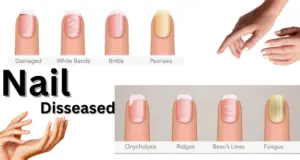Introduction: nail abnormalities
Welcome to our comprehensive guide on understanding and dealing with nail abnormalities. Your nails are more than just a fashion accessory; they can provide valuable insights into your overall health. In this post, we will delve into the various types of nail abnormalities ,their causes ,and effective strategies to address them. So ,let’s dive in and nail it!
Types of Nail Abnormalities:
- Brittle Nails:
- Causes: Nutritional deficiencies, frequent exposure to water, and excessive use of nail products.
- Treatments: Moisturizing, avoiding harsh chemicals, and maintaining a balanced diet rich in vitamins and minerals.
- Discolored Nails:
- Causes: Fungal infections, trauma, underlying health conditions, or certain medications.
- Treatments: Antifungal treatments, protecting nails from trauma, and addressing any underlying health issues.
- Ridged Nails:
- Causes: Aging, nutritional deficiencies, certain diseases, or trauma to the nail bed.
- Treatments: Nail buffing, moisturizing, improving diet, and addressing any underlying medical conditions.
- Spoon-shaped Nails:
- Causes: Iron deficiency anemia, trauma, or certain genetic disorders.
- Treatments: Treating the underlying cause, iron supplements, protecting nails from trauma.
- Pitting:
- Causes: Psoriasis, eczema, or other skin conditions.
- Treatments: Managing the underlying skin condition, moisturizing, and protecting nails from further damage.
Dealing with Nail Abnormalities
Brittle Nails:
- Hydration: Keep your nails hydrated by moisturizing your hands and nails regularly. Use cuticle oil to lock in moisture.
- Gentle Handling: Avoid using your nails as tools to prevent brittleness. Wear gloves when performing household chores.
Yellowing or Discoloration:
- Quality Nail Polish: Use a clear base coat before applying colored nail polish to prevent staining.
- Avoid Smoking: Smoking can lead to yellowing of nails. Quitting smoking can improve nail appearance.
Ridges or Grooves:
- Nail Buffing: Gently buff ridges using a nail buffer to create a smoother surface.
- Nail Strengtheners: Consider using nail strengtheners containing vitamins and minerals to improve nail texture.
White Spots:
- Healthy Diet: White spots can indicate nutrient deficiencies. Ensure your diet is well-balanced and includes a variety of vitamins and minerals.
- Avoid Trauma: Protect your nails from trauma to prevent the formation of white spots.
Ingrown Nails:
- Proper Trimming: Trim your nails straight across and avoid rounding the corners to prevent ingrown nails.
- Opt for comfortable shoes that offer ample space for your toes, preventing any undue pressure on your nails.
Nail Fungus:
- Good Hygiene: Keep your nails clean and dry to prevent fungal growth.
- Antifungal Treatment: Over-the-counter antifungal creams or treatments can help manage mild fungal infections.
Consult a Professional:
- Dermatologist Visit: If you notice persistent or severe nail abnormalities, consult a dermatologist for accurate diagnosis and treatment.
- Nail Technician: Seek advice from a nail technician for guidance on nail care products and techniques.
Overall Nail Health:
- Balanced Diet: Consume foods rich in vitamins and minerals to promote healthy nails.
- Limit Harsh Chemicals: Minimize exposure to harsh cleaning agents that can weaken nails.
Prevention is Key
Taking preventive measures can significantly reduce the risk of nail abnormalities. Here are some additional tips to maintain healthy nails:
- Protect Your Nails: Wear gloves while doing household chores, gardening, or using cleaning products to shield your nails from harsh chemicals and potential damage.
- Limit Gel and Acrylic Use: While gel and acrylic nails can be aesthetically appealing, their frequent use can weaken and damage your natural nails.
- Proper Nail Cutting: Trim your nails straight across and avoid cutting them too short. Cutting nails too close to the skin can lead to painful ingrown nails.
- Nail File Technique: Use a gentle file and avoid aggressive filing, as it can weaken the nail structure.
- Stay Hydrated: Drinking enough water contributes to overall nail health by keeping them hydrated and less prone to brittleness.
- Regular Manicures and Pedicures: Schedule regular professional manicures and pedicures to maintain nail health and address any concerns with a trained nail technician.
- Limit Nail Polish Use: Allow your nails to go polish-free for a few days between applications to prevent discoloration and maintain their natural strength.
- Supplement Care: Consider taking supplements rich in biotin, vitamin E, and other essential nutrients known to promote nail health. Consult a healthcare professional before starting any new supplements.
FAQs
Q1: Can nail abnormalities be a sign of serious health conditions? A1: Yes, certain nail abnormalities can indicate underlying health issues. It’s essential to consult a healthcare professional for a proper diagnosis.
Q2: How can I prevent nail abnormalities? A2: Maintaining a balanced diet, avoiding excessive use of nail products, and protecting your nails from trauma can help prevent nail abnormalities.
Q3: Should I seek medical attention for nail abnormalities? A3: If you notice severe or persistent nail abnormalities, it’s advisable to seek medical advice to rule out any underlying health conditions.
Conclusion:
Your nails deserve attention, as they can provide important clues about your overall well-being. By understanding the different types of nail abnormalities and their causes, you can take proactive steps to maintain healthy nails. Remember to consult a healthcare professional for proper diagnosis and treatment. Nail it by embracing healthy habits and flaunting those beautiful nails with confidence!
You may also love to read
When Nails Get Curvy: Nail Clubbing Demystified
Visual Encyclopedia of Nail Abnormalities – Causes, Symptoms

